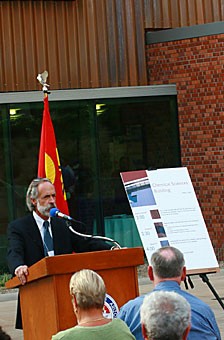The new Chemical Sciences building was unveiled to the public yesterday in a dedication ceremony that highlighted its 14 additional state-of-the-art research laboratories and seven high-tech support facilities.
The 85,000-square-foot building, which cost about $50 million, has been under consideration for more than 20 years and under construction for two.
It stands directly next to the Henry Koffler and Old Chemistry buildings, which will remain up and running for less complicated laboratory work.
Mark Smith, head of the chemistry department, said the new building was constructed because the department has outgrown the space allotted for it.
“”We’re still smaller than we should be, but the expansion allows us to perform all of the funded work that we have going on,”” Smith said. “”We now have the ability to bring in first-rate scientists, research groups and facilities to the campus.””
The new building will allow the department
We’re still smaller than we should be, but the expansion allows us to perform all of the funded work that we have going on. We now have the ability to bring in first-rate scientists, research groups and facilities to the campus.
– Mark Smith,
head of the chemistry department
to house more than 200 graduate students, Smith said.
“”The history of this building goes back to the time that I first arrived on campus,”” Smith said. “”The importance of qualified buildings for research continues to grow.””
“”If you look where science and technology are going, always in the middle is chemistry,”” said Joaquin Ruiz, dean of the College of Science.
The labs in the older chemistry buildings are trapped in the 18th century, Ruiz said.
President Robert Shelton said world-class research needs a world-class building.
“”You’re going to make us proud by the work you do in that building,”” Shelton said, addressing the students and faculty whose work in the new building has already begun.
“”The staff and graduate students moved in a few weeks ago,”” Ruiz said. “”They are cranking away as we speak.””
The Chemical Sciences building will be home to research in areas including biomolecular design and mechanisms, materials chemistry for new technologies in electro-optics and homeland security and the astrochemistry of planetary and interstellar media, according to the chemistry department Web site.
Following the speeches, the guests were given the opportunity to take self-given or group tours of the building’s several laboratories and facilities.
A timeline was displayed in the lobby, showing the development of the chemistry department from its origin in 1983 until today. A complimentary buffet also greeted visitors to the building.
Smith said the building means more than just research for the chemistry department.
“”It means research and training all across campus,”” Smith said.









